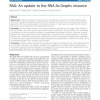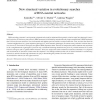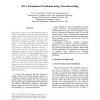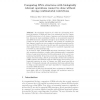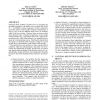BMCBI
2011
13 years 11 months ago
2011
Background: In 2004, we presented a web resource for stimulating the search for novel RNAs, RNA-As-Graphs (RAG), which classified, catalogued, and predicted RNA secondary structur...
BMCBI
2011
14 years 2 months ago
2011
Background: With continuing identification of novel structured noncoding RNAs, there is an increasing need to create schematic diagrams showing the consensus features of these mol...
IPL
2006
14 years 7 months ago
2006
The Arc-Preserving Subsequence (APS) problem appears in the comparison of RNA structures in computational biology. Given two arcannotated sequences of length n and m < n, APS a...
BMCBI
2007
14 years 7 months ago
2007
Background: We investigate the empirical complexity of the RNA secondary structure design problem, that is, the scaling of the typical difficulty of the design task for various cl...
BIOSYSTEMS
2007
14 years 7 months ago
2007
RNA secondary structure is an important computational model to understand how genetic variation maps into phenotypic (structural) variation. Evolutionary innovation in RNA structu...
CPM
2008
Springer
14 years 9 months ago
2008
Springer
We present an algorithm for computing the edit distance of two RNA structures with arbitrary kinds of pseudoknots. A main benefit of the algorithm is that, despite the problem is N...
BIBE
2005
IEEE
15 years 29 days ago
2005
IEEE
RNA plays a critical role in mediating every step of cellular information transfer from genes to functional proteins. Pseudoknots are widely occurring structural motifs found in a...
COCOON
2007
Springer
15 years 1 months ago
2007
Springer
Given an RNA family characterized by conserved sequences and folding constraints, the problem is to search for all the instances of the RNA family in a genomic database. As seed-ba...
WALCOM
2010
IEEE
15 years 2 months ago
2010
IEEE
Abstract. Arc-annotated sequences are useful for representing structural information of RNAs and have been extensively used for comparing RNA structures in both terms of sequence a...
RECOMB
2002
Springer
15 years 7 months ago
2002
Springer
